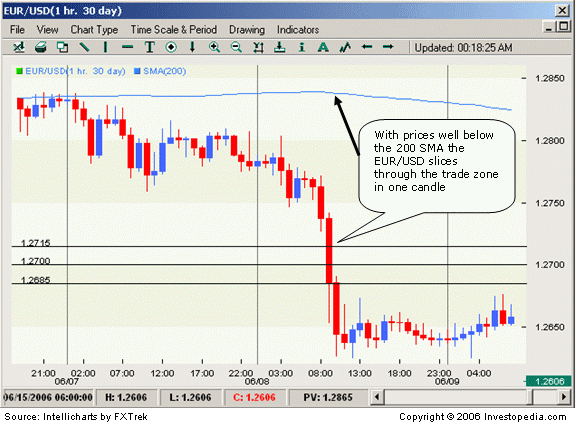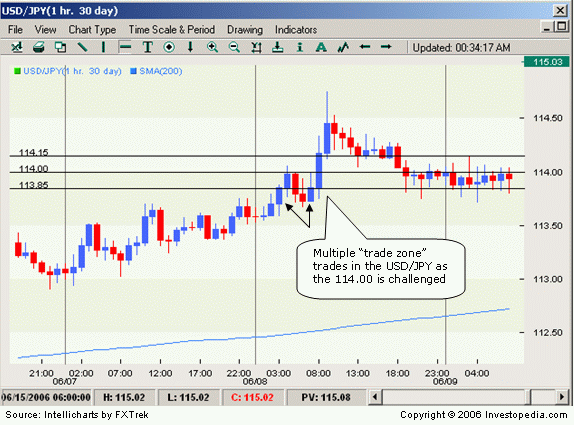The forex market is the most leveraged financial market in the world. In equities, standard margin is set at 2:1, which means that a trader must put up at least $50 cash to control $100 worth of stock. In options, the leverage increases to 10:1, with $10 controlling $100. In the futures markets, the leverage factor is increased to 20:1.
For example, in a Dow Jones futures e-mini contract, a trader only needs $2,500 to control $50,000 worth of stock. However, none of these markets approaches the intensity of the forex market, where the default leverage at most dealers is set at 100:1 and can rise up to 200:1. That means that a mere $50 can control up to $10,000 worth of currency. Why is this important? First and foremost, the high degree of leverage can make FX either extremely lucrative or extraordinarily dangerous, depending on which side of the trade you are on.
In FX, retail traders can literally double their accounts overnight or lose it all in a matter of hours if they employ the full margin at their disposal, although most professional traders limit their leverage to no more than 10:1 and never assume such enormous risk. But regardless of whether they trade on 200:1 leverage or 2:1 leverage, almost everyone in FX trades with stops. In this article, you'll learn how to use stops to set up the "stop hunting with the big specs" strategy.
Stops are KeyPrecisely because the forex market is so leveraged, most market players understand that stops are critical to long-term survival. The notion of "waiting it out," as some equity investors might do, simply does not exist for most forex traders. Trading without stops in the currency market means that the trader will inevitably face forced liquidation in the form of a margin call. With the exception of a few long-term investors who may trade on a cash basis, a large portion of forex market participants are believed to be speculators, therefore, they simply do not have the luxury of nursing a losing trade for too long because their positions are highly leveraged.
Because of this unusual duality of the FX market (high leverage and almost universal use of stops), stop hunting is a very common practice. Although it may have negative connotations to some readers, stop hunting is a legitimate form of trading. It is nothing more than the art of flushing the losing players out of the market. In forex-speak they are known as weak longs or weak shorts. Much like a strong poker player may take out less capable opponents by raising stakes and "buying the pot," large speculative players (like investment banks, hedge funds and money center banks) like to gun stops in the hope of generating further directional momentum. In fact, the practice is so common in FX that any trader unaware of these price dynamics will probably suffer unnecessary losses.
Because the human mind naturally seeks order, most stops are clustered around round numbers ending in "00." For example, if the EUR/USD pair was trading at 1.2470 and rising in value, most stops would reside within one or two points of the 1.2500 price point rather than, say, 1.2517. This fact alone is valuable knowledge, as it clearly indicates that most retail traders should place their stops at less crowded and more unusual locations.
More interesting, however, is the possibility of profit from this unique dynamic of the currency market. The fact that the FX market is so stop driven gives scope to several opportunistic setups for short-term traders. In her book "Day Trading The Currency Market" (2005), Kathy Lien describes one such setup based on fading the "00" level. The approach discussed here is based on the opposite notion of joining the short-term momentum.
Taking Advantage of the HuntThe "stop hunting with the big specs" is an exceedingly simple setup, requiring nothing more than a price chart and one indicator. Here is the setup in a nutshell: on a one-hour chart, mark lines 15 points of either side of the round number. For example, if the EUR/USD is approaching the 1.2500 figure, the trader would mark off 1.2485 and 1.2515 on the chart. This 30-point area is known as the "trade zone," much like the 20-yard line on the football field is known as the "redzone." Both names communicate the same idea – namely that the participants have a high probability of scoring once they enter that area.
The idea behind this setup is straightforward. Once prices approach the round-number level, speculators will try to target the stops clustered in that region. Because FX is a decentralized market, no one knows the exact amount of stops at any particular "00" level, but traders hope that the size is large enough to trigger further liquidation of positions – a cascade of stop orders that will push price farther in that direction than it would move under normal conditions.
Therefore, in the case of long setup, if the price in the EUR/USD was climbing toward the 1.2500 level, the trader would go long the pair with two units as soon as it crossed the 1.2485 threshold. The stop on the trade would be 15 points back of the entry because this is a strict momentum trade. If prices do not immediately follow through, chances are the setup failed. The profit target on the first unit would be the amount of initial risk or approximately 1.2500, at which point the trader would move the stop on the second unit to breakeven to lock in profit. The target on the second unit would be two times initial risk or 1.2515, allowing the trader to exit on a momentum burst.
Aside from watching these key chart levels, there is only one other rule that a trader must follow in order to optimize the probability of success. Because this setup is basically a derivative of momentum trading, it should be traded only in the direction of the larger trend. There are numerous ways to ascertain direction using technical analysis, but the 200-period simple moving average (SMA) on the hourly charts may be particularly effective in this case. By using a longer term average on the short-term charts, you can stay on the right side of the price action without being subject to near-term whipsaw moves.
Let's take a look at two trades – one a short and the other a long – to see how this setup is traded in real time.

Figure 1
Note that in this example, on June 8, the EUR/USD is trading well below its 200 SMA, indicating that the pair is in a strong downtrend (Figure 1). As prices approach the 1.2700 level from the downside, the trader would initiate a short the moment price crosses the 1.2715 level, putting a stop 15 points above the entry at 1.2730. In this particular example, the downside momentum is extremely strong as traders gun stops at the 1.2700 level within the hour. The first half of the trade is exited at 1.2700 for a 15-point profit and the second half is exited at 1.2685 generating 45 points of reward for only 30 points of risk.

Figure 2
The example illustrated in Figure 2 also takes place on the same day, but this time in the USD/JPY the "trade-zone" setup generates several opportunities for profit over a short period of time as key stop cluster areas are probed over and over. In this case, the pair trades well above its 200 period SMA and, therefore, the trader would only look to take long setups. At 3 a.m. EST, the pair trades through the 113.85 level, triggering a long entry. In the next hour, the longs are able to push the pair through the 114.00 stop cluster level and the trader would sell one unit for a 15-point profit, immediately moving the stop to breakeven at 113.85. The longs can't sustain the buying momentum and the pair trades back below 113.85, taking the trader out of the market. Only two hours later, however, prices once again rally through 113.85 and the trader gets long once more. This time, both profit targets are hit as buying momentum overwhelms the shorts and they are forced to cover their positions, creating a cascade of stops that verticalize prices by 100 points in only two hours.
The Bottom LineThe "stop hunt with the big specs" is one of the simplest and most efficient FX setups available to short-term traders. It requires nothing more than focus and a basic understanding of currency market dynamics. Instead of being victims of stop hunting expeditions, retail traders can finally turn the tables and join the move with the big players, banking short-term profits in the process.